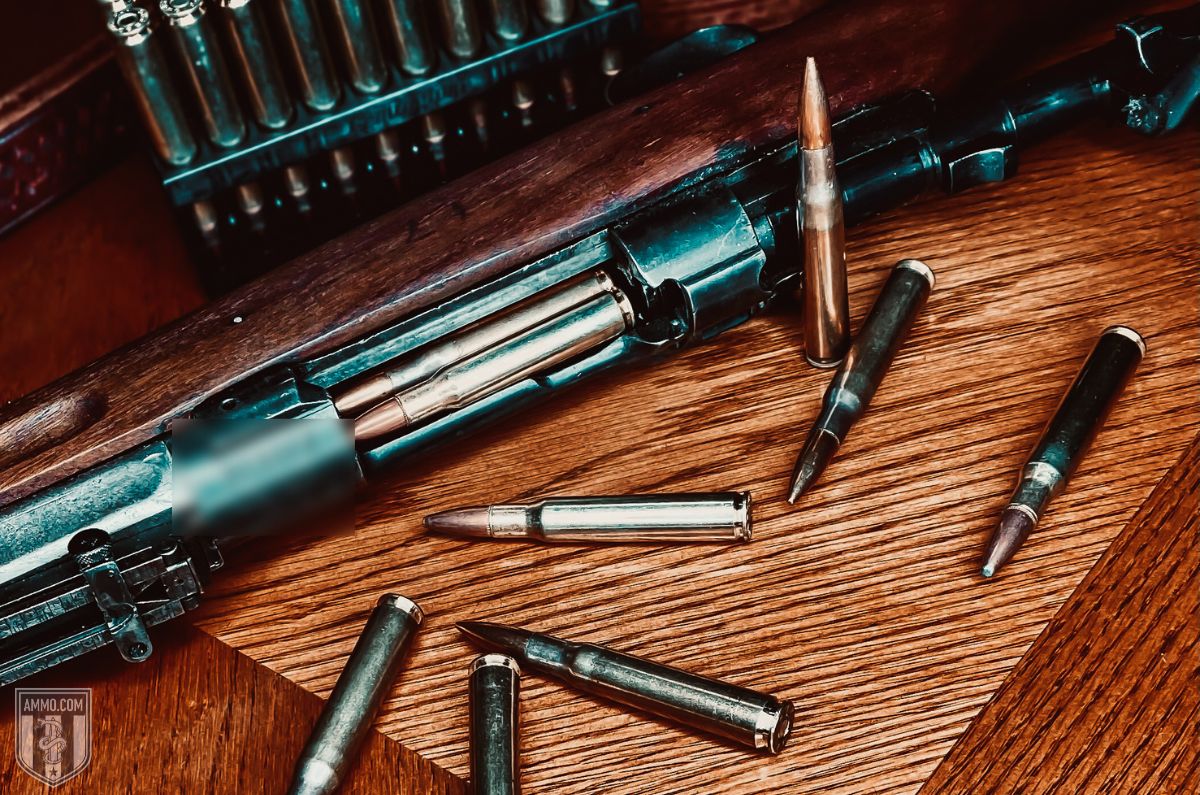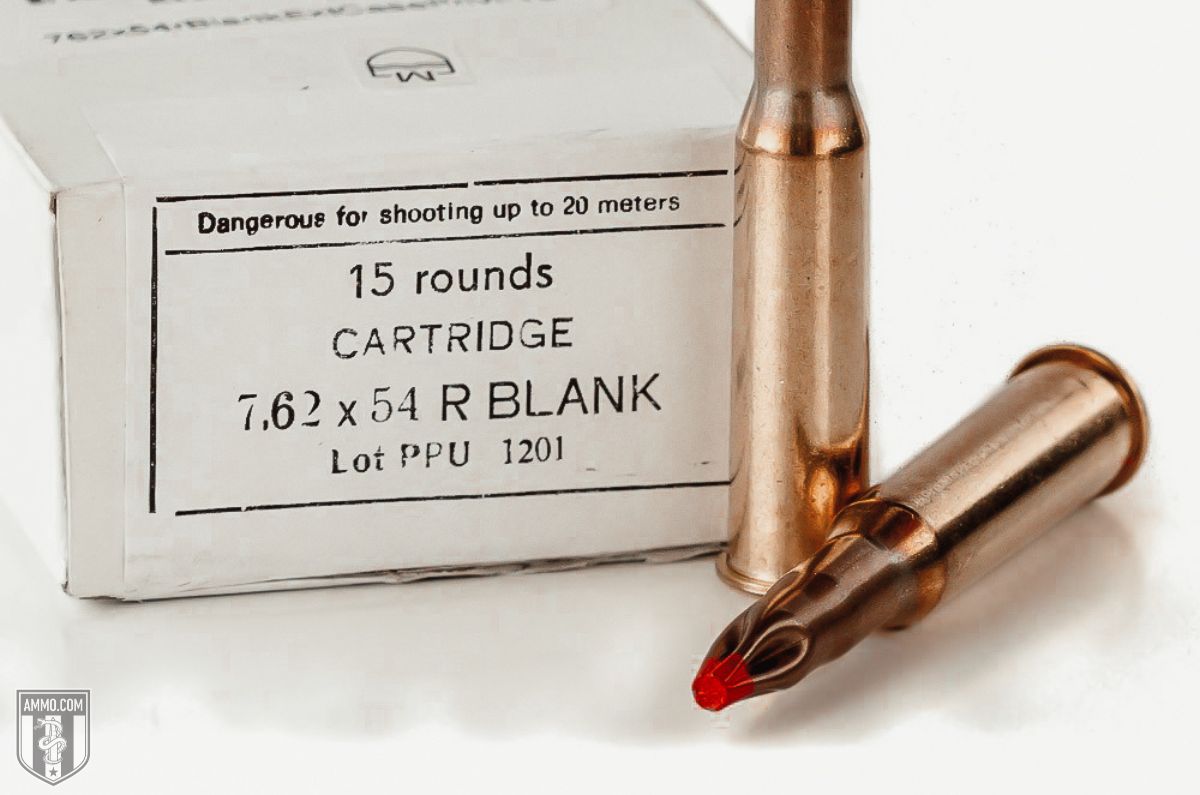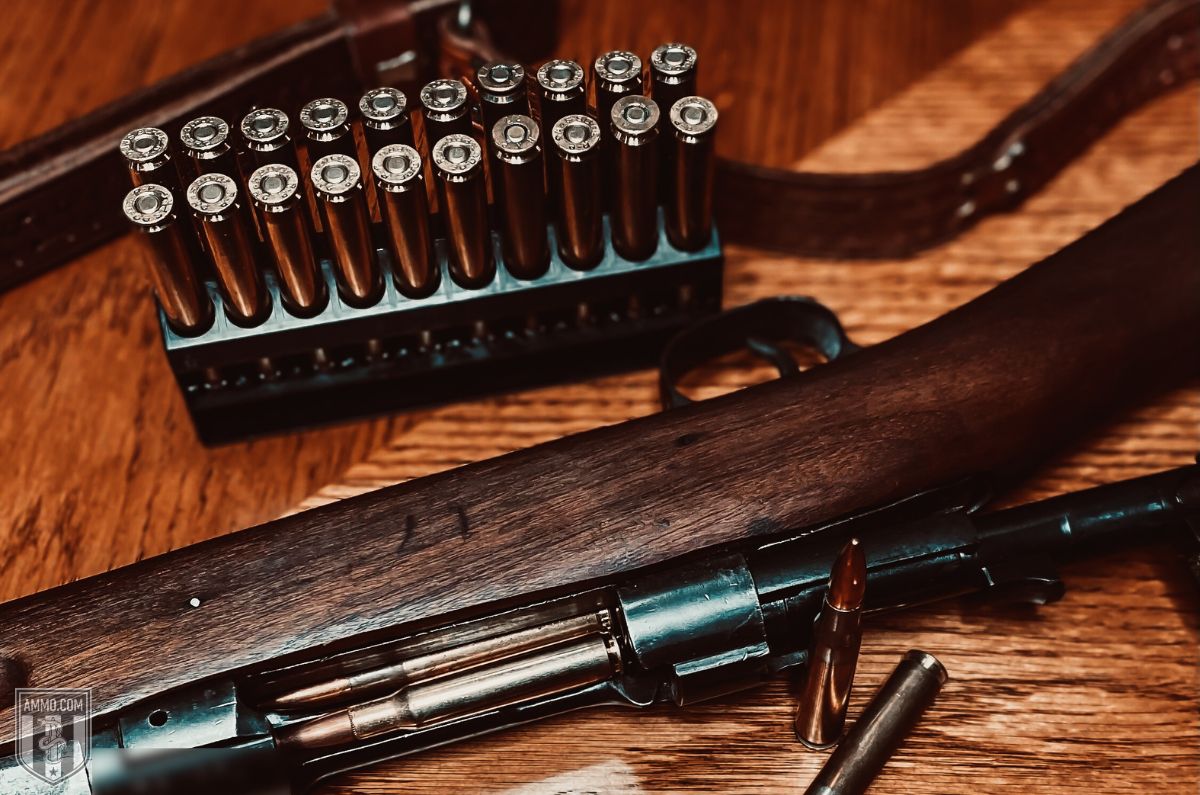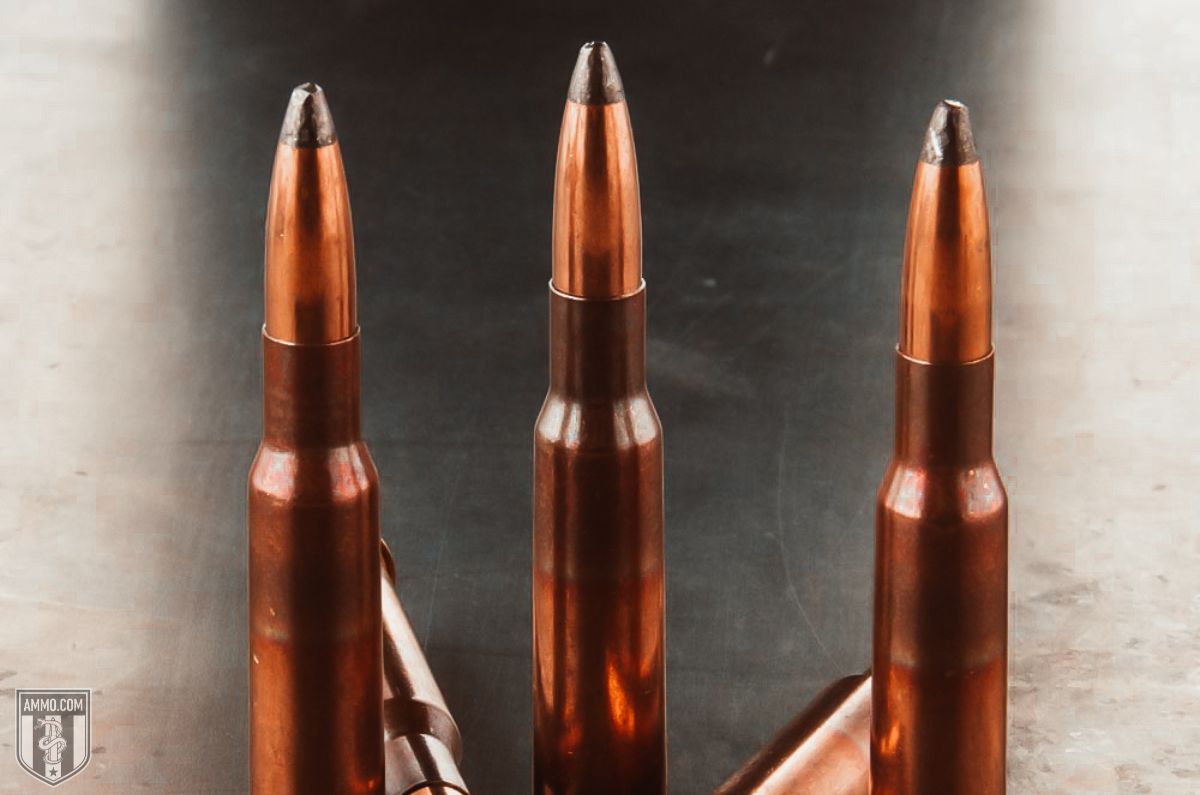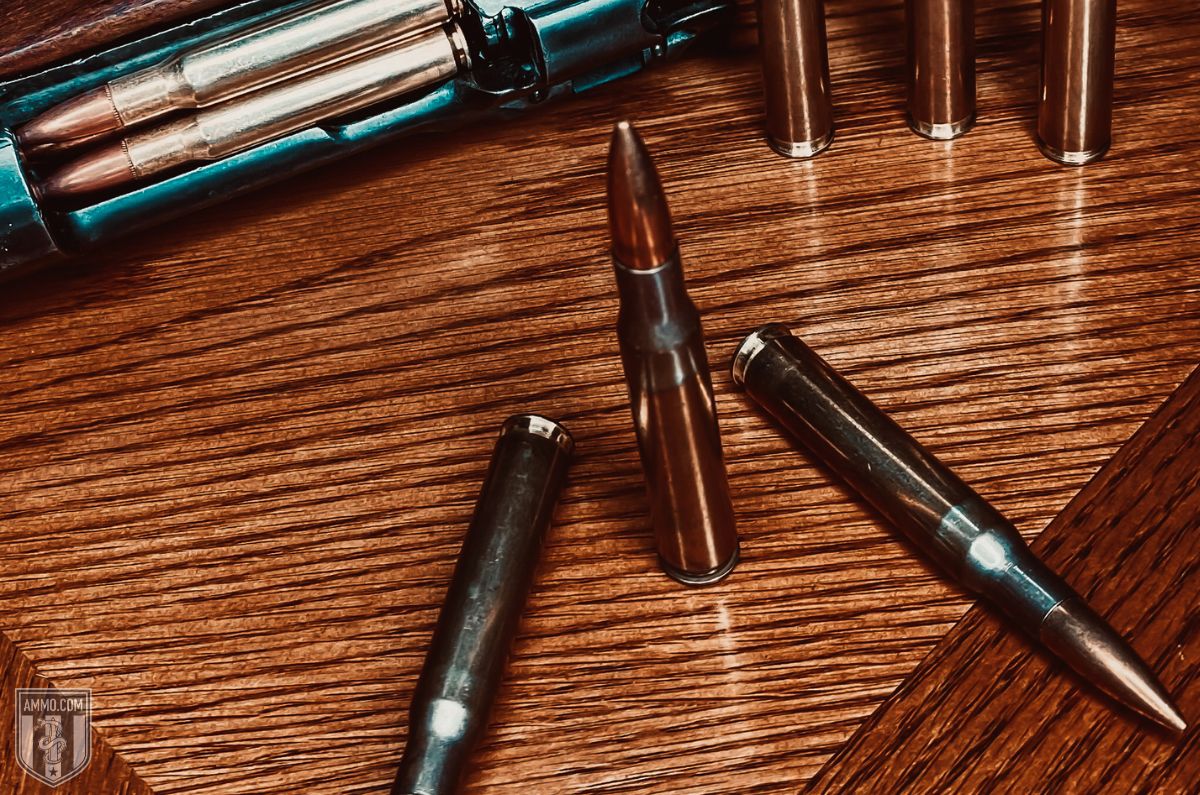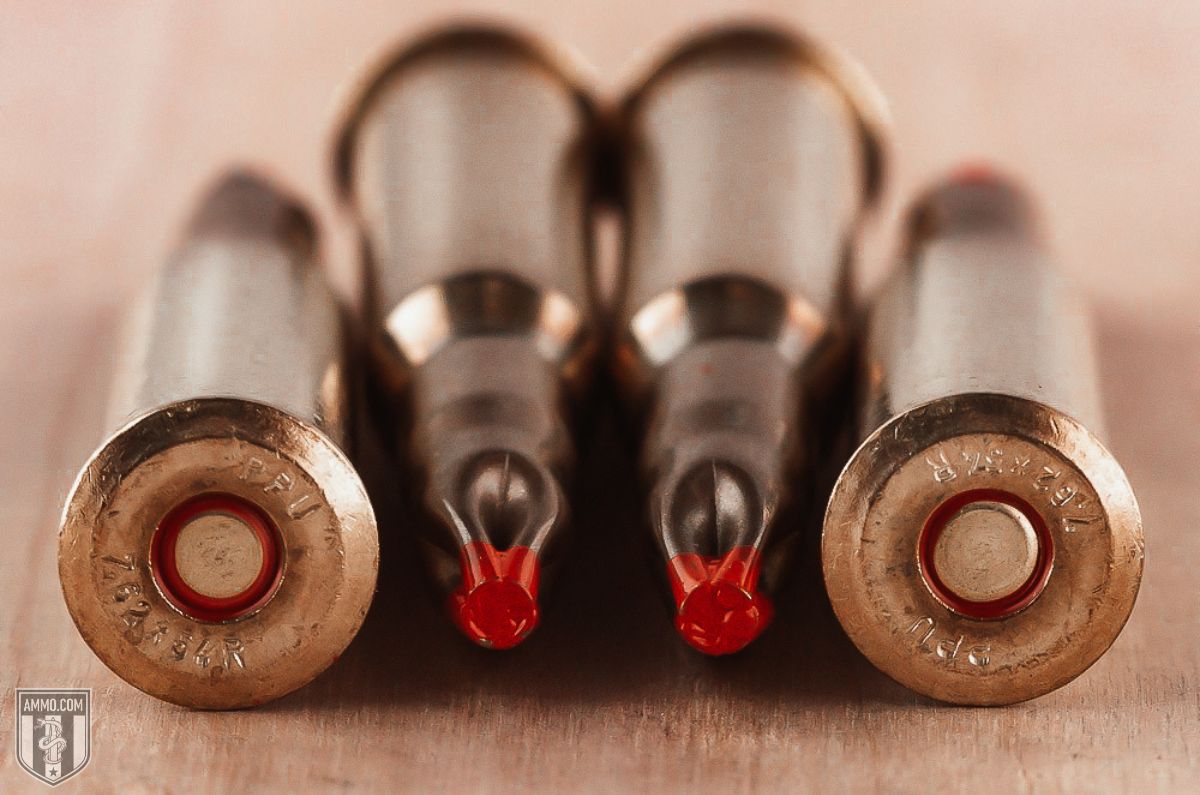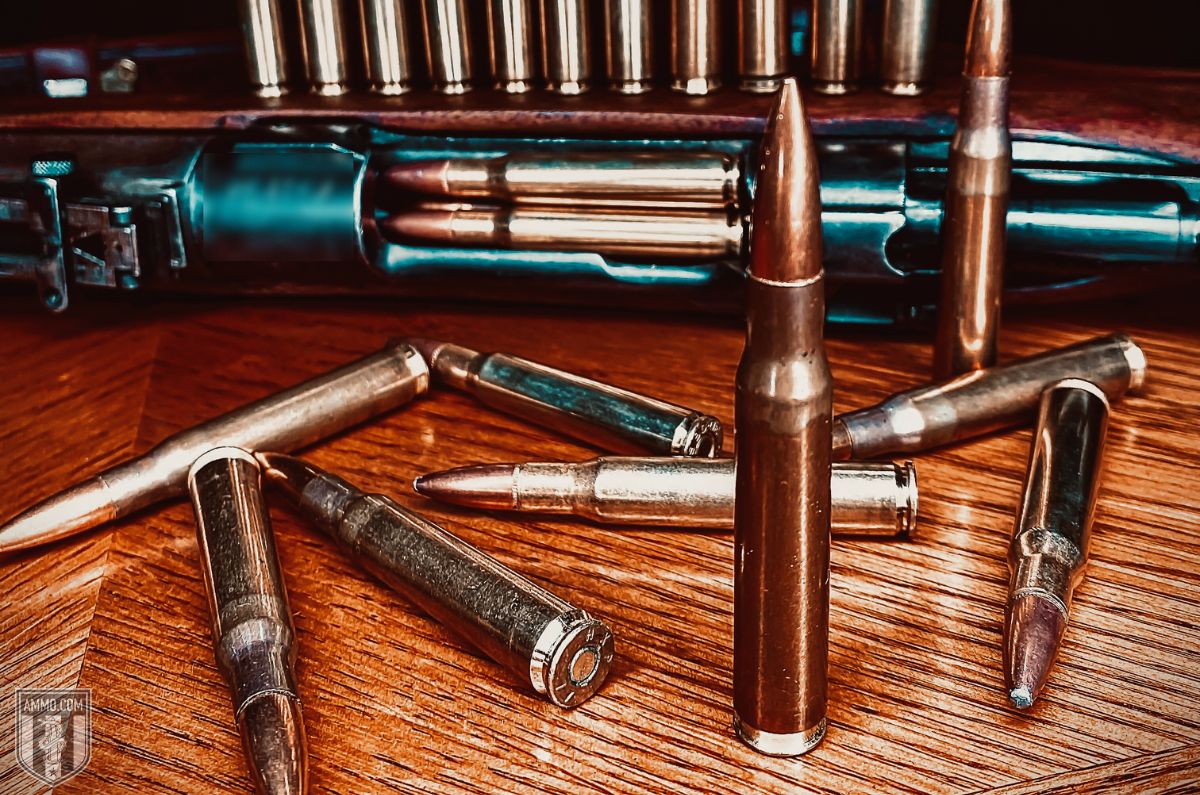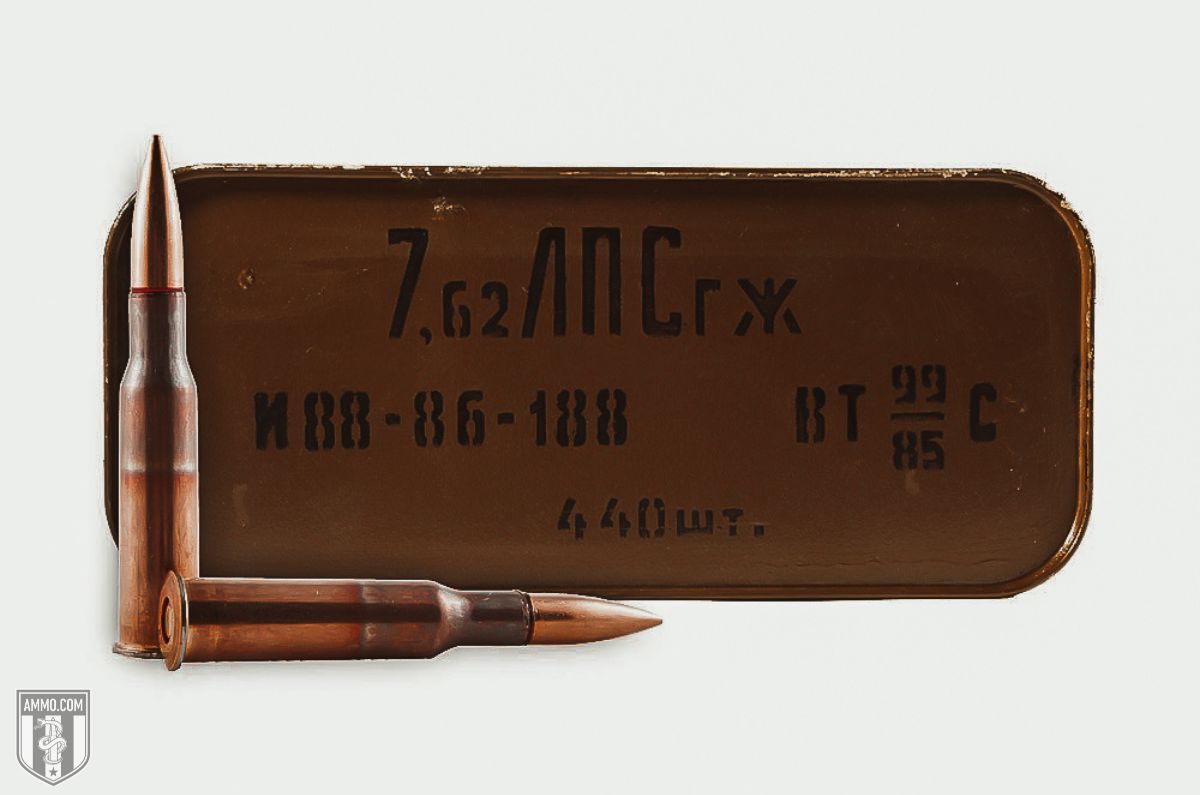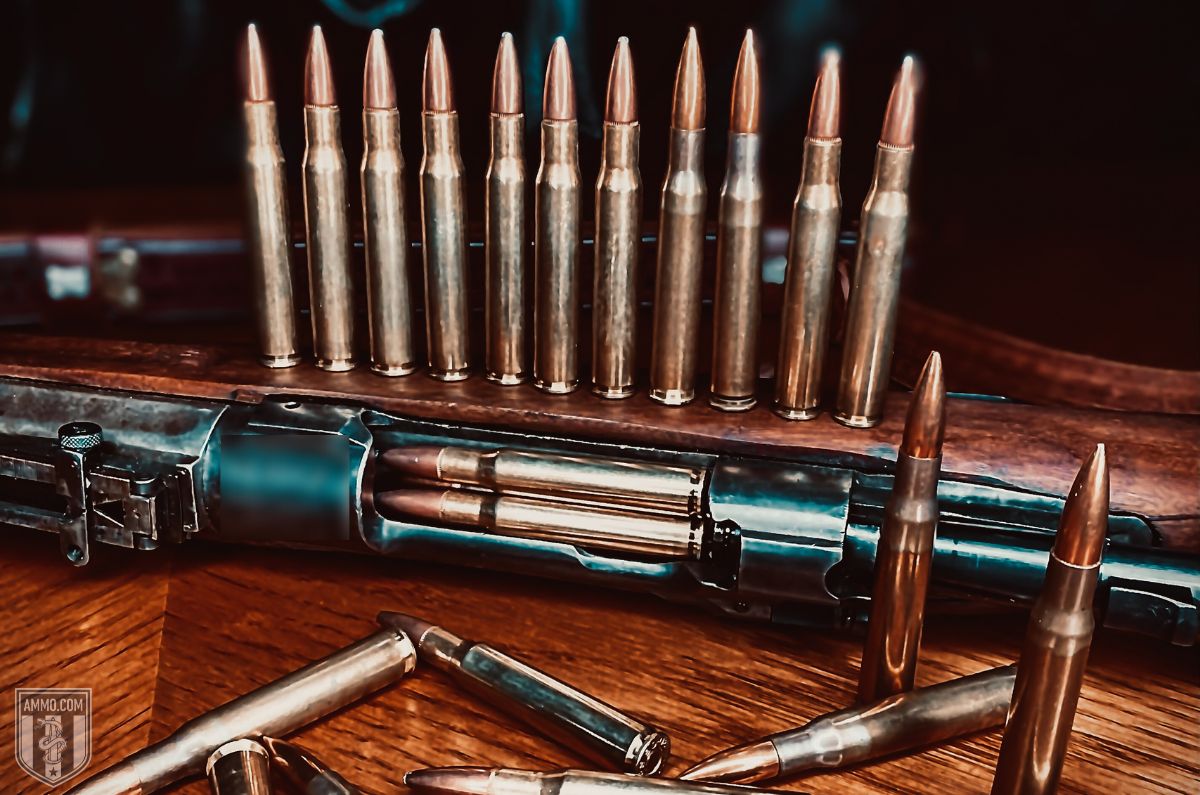30 06 vs 7.62 x54R: The Iconic Rifle Cartridges of WWII
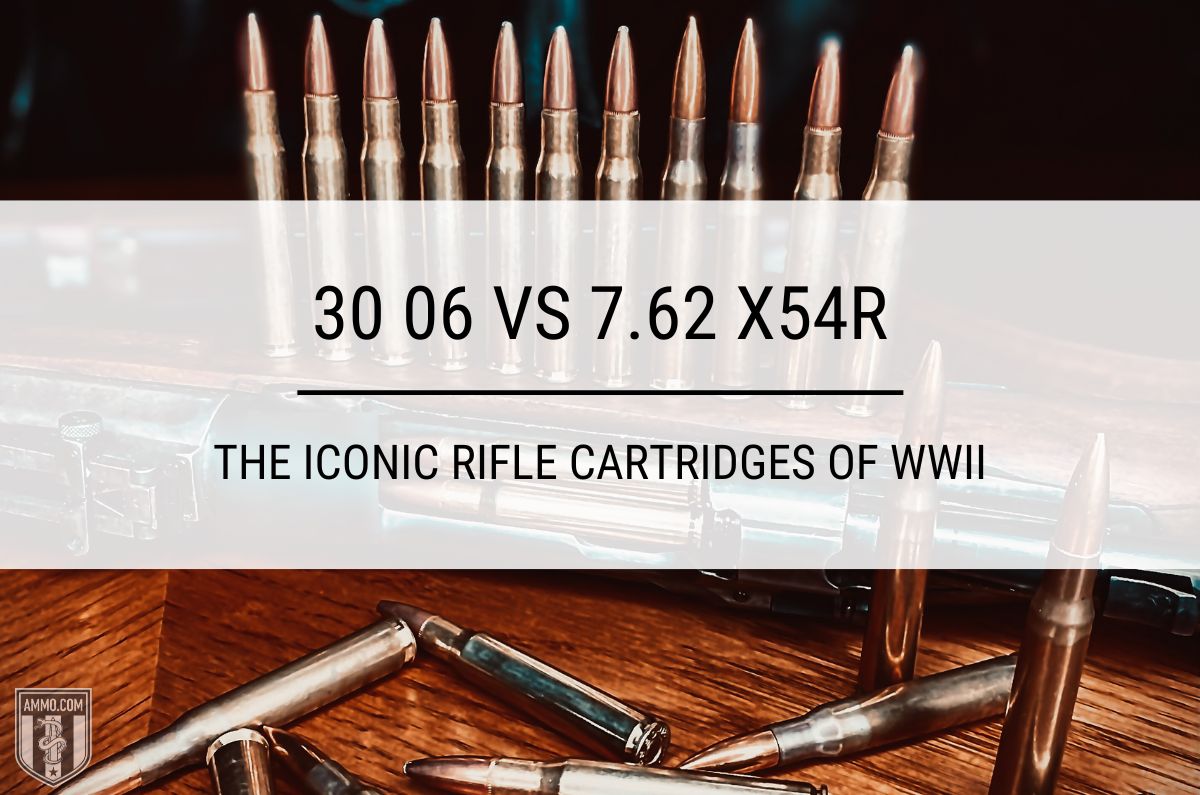
First Shots: 30 06 vs 7.62 x54R
When I think about the most iconic rifle cartridges of World War II, my mind immediately goes to the American 30-06 Springfield and the Russian 7.62x54R. The 303 British and 8mm Mauser played a critical role in that conflict as well, but if I had to choose two cartridges that won the European theater, the 30-06 and 7.62x54R would be my picks.
Although both rounds are relatively similar in terms of ballistics, the 30-06 Springfield is considerably more popular in North America and has a multitude of ammo and firearms available for it. In contrast, most 7.62x54R rifles and ammo will be from older Russian military surplus.
Considering that both rifle cartridges are relatively equivalent to each other, many new shooters wonder if they should pick the round that stormed the beaches of Normandy (30-06) or the hero of Stalingrad (7.62x54R)?
In this article, we will evaluate the 7.62x54R vs 30-06 to help you understand the differences between the two and give you a clearer understanding of which cartridge is best for your shooting and big game hunting needs.
What is the difference between the 30 06 and the 7.62x54R?
The main difference between the 30 06 and the 7.62x54R is in their case design, as the 7.62x54R is a rimmed cartridge while the 30-06 is rimless. Furthermore, the 30-06 cartridge case is slightly longer than its Russian counterpart, meaning the 30-06 will have slightly higher case capacity and can fire heavier bullets.
Cartridge Specs
When evaluating centerfire cartridges, it’s a good idea to analyze the cartridge specs to gain more knowledge of each.
Both the 30 06 and 7.62x54R were developed around the same time, with the Russian round being released in 1891 while the 30-06 was finalized in 1906. Both rounds saw their first major battlefield use in trenches of World War I and were still the cartridges of choice for their respective nations in WWII.
The 30-06 Springfield was developed as the U.S. military’s response to the losses suffered at the hands of the 7mm Mauser round during the Spanish-American War. The 30-06 was originally chambered in the 1903 Springfield bolt-action rifle and was later adapted to the semi-automatic M1 Garand.
The 7.62x54R was initially developed for the bolt-action Mosin Nagant rifle. However, it is currently in use with machine guns like the PKM and the PKP as well as the PSL and Dragunov sniper rifles.
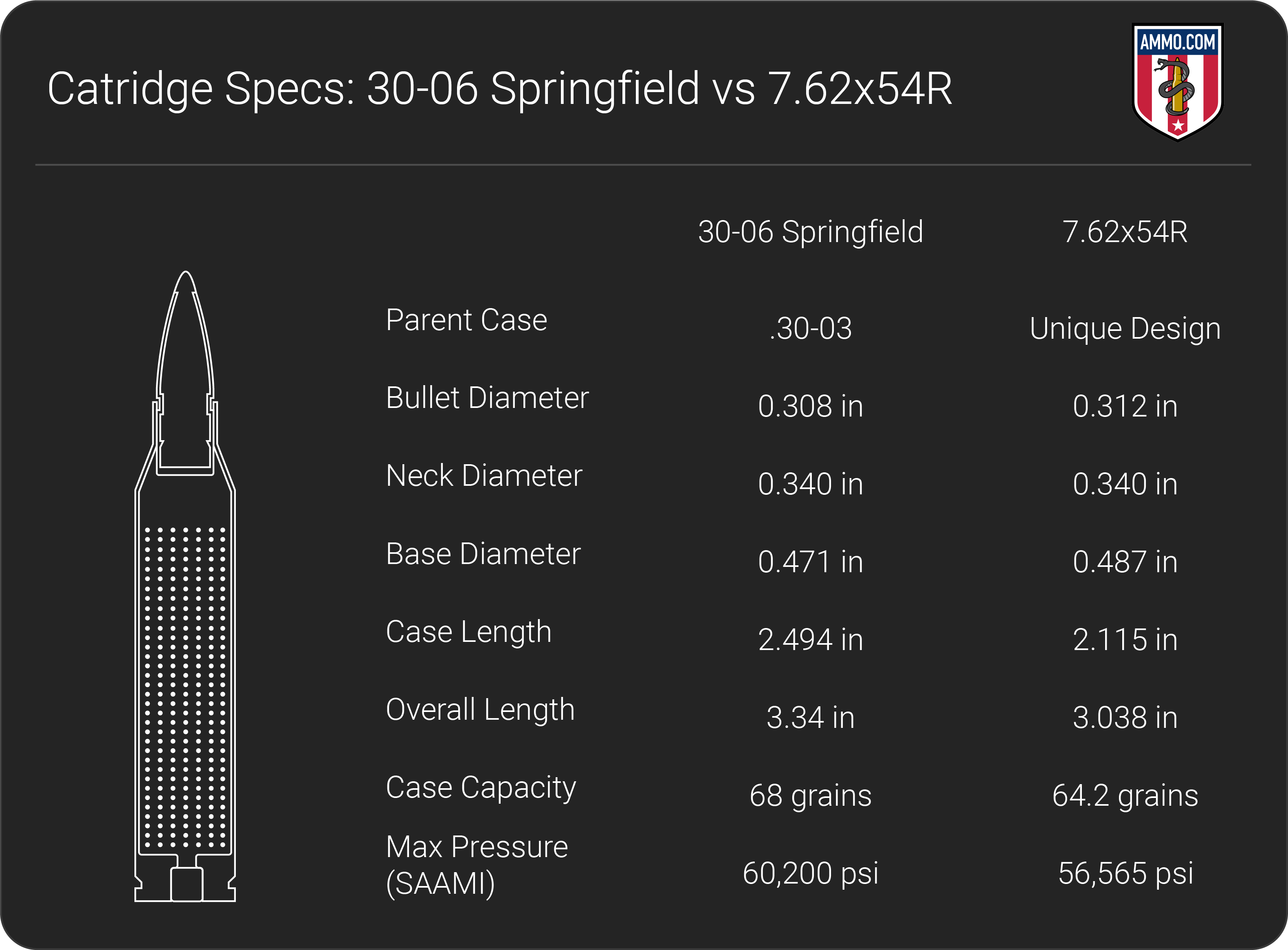
The most obvious difference between these old warhorses is that the 7.62x54R is a rimmed cartridge while the 30-06 is rimless. This is a point of confusion with some new shooters, as they believe that the “R” in the cartridge name means “Russian” when it actually means “Rimmed”.
The 7.62x54R is the second longest-serving military cartridge in history as it is still in use today, surpassed in longevity only by the 303 British. Interestingly, the 303 and 7.62 are the only rimmed cartridges still in active military service.
Looking at these two rounds side-by-side, it is easy to see that the 30-06 is the larger cartridge of the two. With an overall length of 3.34”, the 30 06 stands a good 0.3” taller than the 7.62 as it measures 3.038” in overall length. The case of the 30 06 is also longer at 2.494” compared to 2.115” for the 7.62.
The longer case length gives the 30 06 an advantage in case capacity, but it is not as wide an advantage as you might surmise. The 30-06 has a case capacity of 68 grains while the 7.62 x54R has a respectable case capacity of 64.2 gr.
The 30 06 can also handle slightly higher pressures at 60,200 psi per SAAMI specs. On the other hand, the 7.62 x54R is rated for 56,565 psi.
One other difference that might not be as obvious is that the 7.62x54R fires a slightly wider 0.312” diameter bullet while the 30-06 fires a 0.308” diameter bullet. This can cause a lot of confusion with new shooters as both rounds carry the 7.62 caliber designation (30-06 is 7.62x63mm per NATO specs). This difference in bullet diameters is due to how each country measures nominal bore diameter.
The Russians use an older method for measuring bore diameter, which is to measure the distance across the lands of the rifling. American and NATO cartridge regulatory agencies uses the newer method, which is to measure across the grooves. Therefore, the Russian ammunition requires a slightly wider bullet.
Recoil
Recoil is an important consideration when purchasing a new rifle as a round with heavy recoil will be more difficult to control and will slow your rate of follow up shots. The potential for flinching is also an issue for cartridges with heavy recoil.
Felt recoil will differ from shooter to shooter and is often dependent on firearm choice, stance, and your chosen factory ammo or handloads. However, free recoil is a more objective measure of how hard a cartridge hits based on firearm weight, muzzle velocity, powder charge, and bullet weight.
Both of these massive 30-caliber rounds are known for having high recoil but the 7.62x54R has a reputation for having more recoil than the 30-06. Let’s evaluate these claims.
As these are both classic military cartridges, we will compare the free recoil energy of standard issue ammo in their respective firearms.
For the 30-06 we will consider M2 ball, which is comprised of a 150 grain full metal jacket (FMJ) bullet traveling at 2,740 fps. For the 7.62 Russian, standard issue 7N1 sniper rifle rounds firing a 151 gr match grade bullet traveling at 2,700 fps will be considered.
The test rifles will be the M91/30 Mosin Nagant weighing 8.8 lbs and M1 Garand weighing 9.5 lbs.
Given these criteria, the 30-06 will have 13.9 ft-lbs of free recoil compared to 14.3 ft-lbs for the Russian ammo.
Although the 30 06 has slightly less recoil than the 7.62x54R, the difference is so slight it is unlikely that most shooters will be able to tell the difference.
Why then does the Russian round get such a bad rap for having more recoil than the 30-06? This is a prime example of the difference between felt recoil and free recoil.
Your standard out of the crate M91/30 Mosin-Nagant will not come from the gulag…err…factory with amazing fit and finish. The stock is often ill-fitted, the buttstock is typically very thin, and the stamped metal buttplate does little to help dissipate recoil.
It is true that Finnish Nagants are put together with considerably more care and consideration, however your standard off-the-rack Mosin is going to be a bit rough around the edges.
Compare a Mosin to any rack-grade M1 Garand you would pick up from the CMP and the difference will be obvious. The added rigidity of a tight receiver-to-stock fit and wider buttstock helps disperse the recoil throughout the shoulder instead of focusing it into one small area like the Nagant does.
This is why many shooters describe the recoil from a Mosin as sharp and snappy, where Garand recoil is often described as strong but controllable.
Muzzle Velocity, Kinetic Energy, and Trajectory
Previously we mentioned that the 30-06 Springfield and 7.62x54R were similar in terms of ballistics. To test these claims, we will compare two different factory loads for each cartridge and analyze their performance.
For the 30-06 we will compare the WWII mil-spec 150 grain M2 ball and Hornady Precision Hunter 178 gr ELD-X ammo. The Hornady factory load is not suitable for use in a M1 Garand but is an excellent choice for a modern hunting rifle like a Remington 700.
For the 7.62x54R we will compare the Russian military surplus 7N1 151 gr long range rounds as well as new US-made Winchester 180 gr soft point hunting ammo.
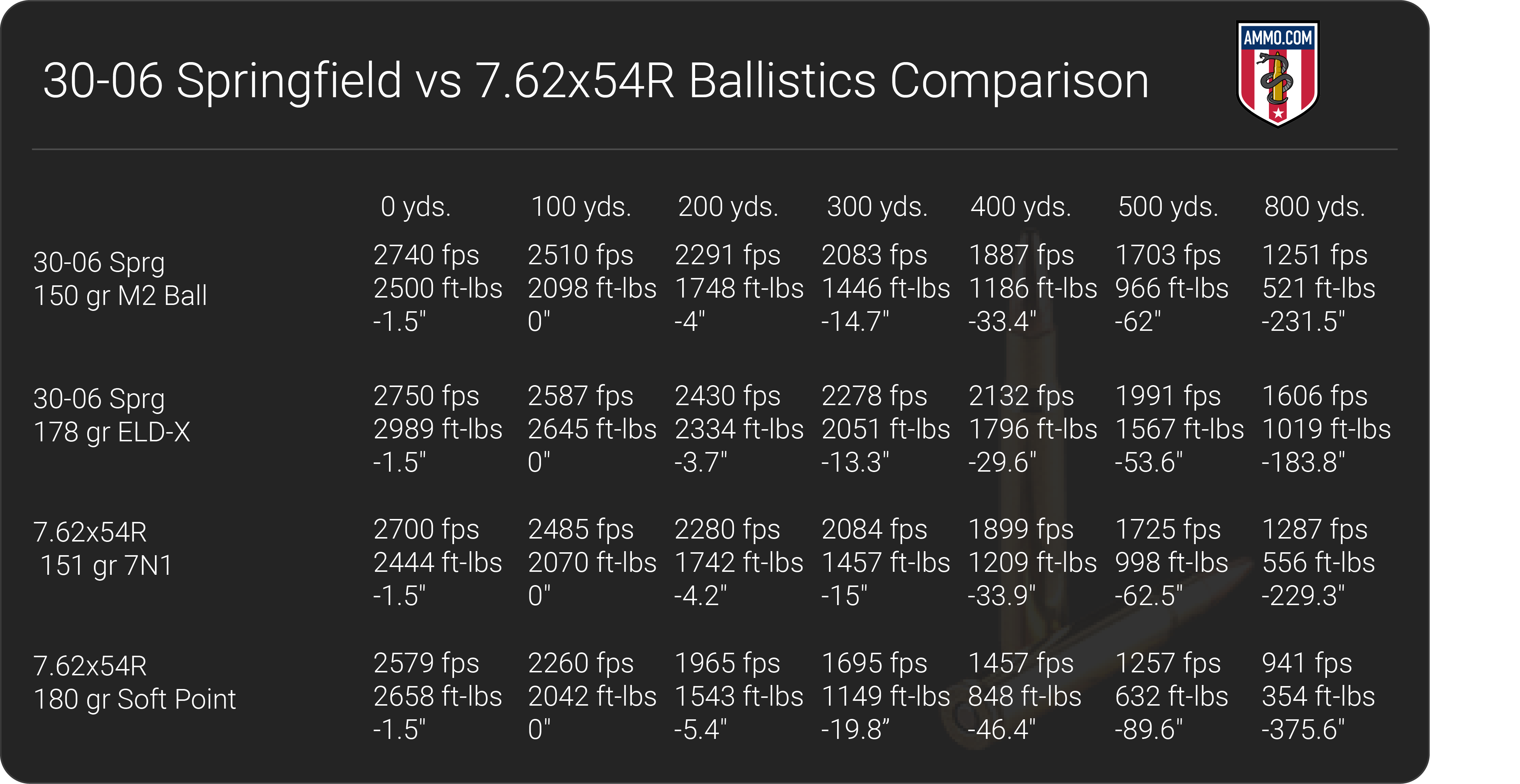
In terms of muzzle velocity, the two Springfield rounds and Russian 7N1 ammo were all extremely close to one another. The Hornady ELD-X ammo had the highest muzzle velocity at 2,750 fps followed closely by the M2 ball ammo at 2,740 fps. The Russian ammo was slightly slower with the 7N1 surplus ammo leaving the barrel at 2,700 fps and the Winchester soft point (SP) being the slowest of the four at 2,579 fps.
At 800 yards, the only round to dip into subsonic velocities was the Winchester 180 gr SP ammo while the three other rounds remained comfortably above supersonic speeds. The ELD-X bullet had the highest velocity at 800 yards, maintaining a comfortable 1,606 fps while the M2 ball and 7N1 ammo were essentially identical at 1,251 fps and 1,287 fps, respectively.
In terms of muzzle energy, the 178 gr ELD-X was the highest with 2,989 foot-pounds of kinetic energy followed by the 180 gr SP for 7.62x54R with 2,658 ft-lbs. The M2 Ball and 7N1 ammo were nearly identical at 2,500 ft-lbs and 2,444 ft-lbs, respectively.
In terms of effective range, the ELD-X bullet was the only factory load that maintained the needed 1,000 ft-lbs of energy to harvest whitetail at 800 yards. The M2 ball and 7N1 ammo, though not a good choice for deer hunting, dipped below 1,000 ft-lbs near 500 yards while the 180 gr SP broke below this barrier near 350 yards.
For long range trajectory, it should come as no surprised that the ELD-X performed the best with -183” of bullet drop at 800 yards. The M2 ball and 7N1 ammo were in the middle of the pack with -231” and -229” of bullet drop, respectively. The Winchester 180 gr SP ammo had the poorest trajectory at 800 yards with -375” of bullet drop as it dropped below subsonic velocities around 600 yards.
So, what conclusions can we draw from these results?
The M2 ball and 7N1 military loads are close enough to be labeled as identical in every ballistic category.
In contrast, the modern loads told a different story entirely, as the Hornady ELD-X 30-06 load was superior to all the other analyzed cartridges. This factory load was selected to showcase the advancements in modern, high-pressure 30-06 ammo.
In general, the 7.62x54R had slightly lower performance when compared to 30-06. However, these ballistic differences are so slight, it is unlikely most shooters would be able to discern any major differences between the two in terms of terminal performance on game animals.
Ballistic Coefficient and Sectional Density
Ballistic coefficient (BC) is a measure of how aerodynamic a bullet is and how well it will resist wind drift. Sectional density (SD) is a way to evaluate the penetration ability of a bullet based on its external dimensions, design, and weight.
Of all the rounds analyzed in the previous section, the Hornady ELD-X had the highest BC at 0.552. The M2 Ball and 7N1 had a BC of 0.417 and 0.411, respectively, while the 180 grain soft point had the lowest BC at 0.267.
For sectional density, the 30-06 and 7.62 were considerably closer based on our research. The Hornady ELD-X had the highest SD at 0.268 while the M2 Ball had a SD of around 0.227. Locating sectional density data for 7.62x54R was tricky as Winchester does not list the SD measurements on their website. However, Russian military documents suggest that 7N1 ammo has a SD of 0.225.
In general, the 30-06 will have a higher ballistic coefficient as it can fire more advanced modern bullets. However, there will be very little discernable difference between the two bullets in terms of penetration.
Hunting
The 30-06 Springfield and 7.62x54R both make excellent medium to large game hunting cartridges.
Both rounds have more than enough kinetic energy for whitetail out to effective range between 350-450 yards depending on your load of choice. For elk, effective range will depend mostly on your chosen factory load as some dip below the recommended 1,500 ft-lbs of kinetic energy by 200 yards while other can maintain this level out to 500 yards.
Although there is nothing inherently wrong with the 7.62x54R, as eastern European hunters have been utilizing this round for game hunting for over a century, most North American hunters will gravitate to the 30-06 Springfield.
After the 30 06 was retired from military service in favor of the 308 Winchester, the 30 06 transitioned from winning wars to harvesting big game almost seamlessly. One of the draws for the 30-06 is its proven track record, as this round has been putting venison in the freezer since after World War I.
However, the major advantage the 30 06 has over the 7.62 Russian is the wide variety of hunting ammo choices for it. If you want to take your Mosin out into the woods, you have essentially one option for hunting bullets: soft points.
Soft point ammo has been used for big game for decades and it is extremely effective. However, as we saw in the ballistics section, these bullets are not known for having an exceptional trajectory and are generally not very aerodynamic.
On the other hand, hunting rounds for the 30 06 have access to a wide variety of expanding bullet options like the Barnes TTSX, Nosler AccuBond, and Sierra GameKing. These polymer tipped bullets allow for excellent aerodynamics while allowing ammo manufacturers to push the envelope of ballistic performance.
Furthermore, the 30 06 can be loaded with 200 and 220 grain bullets, making it a better choice for large game like elk and moose. In contrast, the heaviest bullets loaded for 7.62x54R typically go up to 182 grain bullets.
However, you cannot deny that there is a major “cool factor” of taking an old surplus Mosin into the woods and having a successful hunt while using only iron sights. However, this can also be accomplished using the older 1903 Springfield or a semi-auto M1 Garand
Although there is something rewarding when hunting with a surplus Mosin-Nagant, the wider variety of expanding hunting ammo for 30 06 gives it the edge in the woods.
Ammo and Rifle Cost/Availability
The 30-06 Springfield is one of the top 5 centerfire rifle cartridges sold in North America and is more popular than the 7.62x54R. As such, there is considerably more rifle and ammo options available to the 30-06.
The 30-06 has been ruling the big hunting roost for quite some time, as it is the gold-standard by which all new hunting cartridges are measured by. Furthermore, a considerable amount of research and development has been dedicated to the 30-06 to make it one of the most deadly sporting rifle cartridges in the woods.
With access to a wide variety of ammo, including premium hunting rounds, practice Spitzer FMJs, and even military surplus, ammo cost for the 30-06 is very reasonable given the power level of the cartridge. Furthermore, all of the major ammo manufacturers like Hornady, Winchester, Remington, Browning, Nosler, and Berger offer at least one type of 30-06 ammo.
Inexpensive 30-06 practice ammo can be had for around 1.40/round while premium hunting or match-grade ammo can be had for between $2-4/round.
For the 7.62x54R, there are not as many options for ammo. In the past it wasn’t too hard to find inexpensive Russian or Yugoslavian military surplus ammo available for extremely reasonable prices. However, since the Russian ammo ban, the supply of spam cans full of cheap 7.62x54R has somewhat dried up.
Back in the day, it wasn’t hard to find a spam can of 440 rounds of 7.62 Russian for under $100. Now a days, these spam cans will go for no less than $200 if you can find them, and the primers are corrosive (more on that in the next section).
However, even at $200 per can, this still brings inexpensive plinking ammo in at around $0.50/round for Russian military surplus. For factory new, non-corrosive ammo you should expect to pay around $1.40/round for FMJ ammo and between $1.50-$2/round for hunting soft point ammo at the time of writing.
Speaking of price make sure to check out our stock of Hornady 30-06 ammo for more options.
In terms of firearms, the sky is the limit for the 30-06 while there are only limited options available for the 7.62 x54R.
For the 30-06 you can easily find a military surplus rifle if you like the traditional wood and steel bolt-action. Old 1903 Springfield's and Mausers converted to fire 30-06 are relatively easy to locate.
For more modern hunting rifles, virtually every manufacture has at least one rifle chambered in 30 06.
The Remington 700, Savage 110, Ruger Hawkeye, and Browning X-Bolt are just a few of the popular hunting rifle options for 30-06.
If you fancy a semi-auto, the M1 Garand and Browning BAR are the two most popular options. However, the Ohio Ordnance HCAR, Noreen BN-36, Remington 742 Woodmaster, and Benelli R1 are also semi-automatic 30-06 rifle options if you like something a little different.
At the time of writing, modern American gun manufactures do not offer rifles chambered in 7.62x54R. If you want to fire this caliber, you’ll need to purchase a surplus rifle.
By far the most popular option is the Mosin Nagant bolt-action rifle, as it is one of the most mass-produced rifles in history. With over 37 million rifles produced since 1891, Model 81/30 Nagants used to be a “dime a dozen” at gun shows as dealers would often buy them by the crate.
The standard issue M91/30 Nagant has a 29” barrel length which is great for long range shooting, but no so fun carrying around in the woods all day. If you’d like a bit shorter bolt action rifle, you can find yourself a M38 or M44 carbine with a shorter 20” barrel length.
For semi-auto 7.62x54R you have four primary options: the SVT-40, PSL, Molot VEPR, and SVD Dragunov. All four option are extremely expensive and cost prohibitive for most shooters, as the SVT-40, VEPR, and PSL will go for no less than $1,500 and a parts-matching SVD Dragunov will run well north of $10,000 at the time of writing.
For those hunters who need to use a lever action rifle, neither the 30-06 nor 7.62x54R are offered in this rifle configuration at this time.
A Note on Corrosive Surplus Ammo
In the previous section I mentioned that surplus 7.62x54R ammo used corrosive primers. For any former Comm-Bloc ammo you fire from a spam can, it’s a good bet that it’s corrosive.
Although surplus 30-06 ammo is more difficult to locate now than in years past, if you do find some these headstamps used corrosive primers: FA 56, LC 52, RA 51, SL 52, TW 52, WCC 51, WRA 54, FN 57
Shooting inexpensive corrosive ammo is a great way to save money while sending a lot of rounds downrange. However, proper understanding of what corrosive ammo is and how to clean your firearm after shooting corrosive ammo is the key to keeping your rifle running smoothly and effectively.
If you’d like to read more about corrosive ammo, I did a full write-up about the pros and cons of corrosive ammo as well as an after-shooting cleaning instructions in this article: Corrosive Ammo: Rust Inducing Nightmare or Cheap Plinking Fun?
Reloading
Reloading is one method shooters use to reduce their overall cost per round and increase the consistency and accuracy of their ammo. Furthermore, handloads can be tailored to your rifle to meet your specific shooting needs.
Handloaders have been reloading 30-06 brass since its inception in the early 1900’s. Furthermore, the 30-06 has been the parent case for multiple wildcat cartridges like the 25-06, 7mm-06, 338-06, and more Ackley Improved variants than you can shake a stick at.
Finding 0.308” diameter bullets for the 30-06 is extremely simple as they are also used for popular rounds like the 308 Winchester, 300 Win Mag, and 300 WSM. Furthermore, you cannot beat the bullet varieties available for 30-caliber as you have FMJ Spitzer bullets, military pulls, polymer-tipped, expanding soft-points, and all variants in between at your fingertips.
Loading data for 30-06 is easy to come by as this round has been reloaded for over a century at this point, and a multitude of powders are at your disposal to craft the perfect 30-06 handload.
Although the 7.62x54R has been around longer than the 30-06, there are considerably fewer reloading options for the caliber.
First off, brass cases are hard to come by as Russian military surplus ammo is typically steel cased. To learn more about the difference between steel and brass cased ammo, check out his article: Brass vs Steel Cased Ammo.
This means you’ll need to purchase new factory brass or factory ammo, which is typically more expensive than 30-06 brass.
Even if you could reload the steel cases, most all surplus ammo is Berdan primed. Berdan primers represent an added layer of complexity as you need specialized tools and primers to reload these cases.
Lastly, sourcing 0.311” diameter bullets is more of a challenge. You can find them if you hunt around, as Sierra and Barnes have a few options available. However, there are simply more 0.308” bullets on the market, making it a lot easier to handload for a 30-06 as opposed to the 7.62x54R.
Final Shots: 7.62x54R vs 30 06
The 30-06 and 7.62x54R are two rifle cartridges that changed the course of world history.
The 30-06 Springfield is the American two-time World War champ and can take down any game animal North America can throw at it. It is a piece of United States history and, despite its age, is the big game hunting cartridge that all new rounds are measured by.
To learn more, check out our recommendations for the best 30-06 ammo for accuracy.
The 7.62x54R is the second longest-serving military cartridge in world history as it is still seeing battlefield use to this day. It is the sniper rifle round of choice for the Russian military and cheap surplus ammo is enjoyed by many North American shooters who like to shoot heavy rounds and not break the bank.
Although the cost per round is slightly lower for the 7.62 Russian, most shooters will opt for the 30-06 Springfield thanks to its versatility in ammo variations and plethora of rifle options available for the old war horse.
However, if you want to have similar ballistics to the 30-06 Springfield and don’t necessarily want to pay $4/round for premium hunting ammo, the 7.62x54R makes an excellent alternative if you don’t mind hunting with a surplus Russian rifle.
No matter which cartridge you choose, make sure you stock up on ammunition here at Ammo.com and I’ll see you on the range!
Ammo Comparisons
- .308 vs 5.56
- 6.5 Creedmoor vs .308
- .300 Blackout vs .308
- .300 Win Mag vs .308
- .243 vs .308
- .308 vs .30-06
- 7mm-08 vs .308
- .270 vs .308
- 7.62x39 vs .308
- .223 vs .308
- .338 Lapua vs .308
- .380 ACP vs 9mm
- .223 vs 5.56
- .300 Blackout vs 5.56
- 9mm vs 45 ACP
- 9mm vs 40 S&W
- .357 SIG vs 9mm
- 10mm vs 9mm
- 9mm vs 9mm Luger
- .243 vs .270
- .300 Win Mag vs .30-06
- .270 vs .30-06
- .40 vs .45
- 38 Special vs 357
- 9mm vs 40 vs 45
- 5.56 vs 7.62x39
- 338 Lapua vs .30-06
- .30-30 vs .30-06
- 300 PRC vs 338 Lapua
- .30-06 vs 7mm
- 300 Win Mag vs 338 Lapua
- 300 PRC vs 300 Win Mag
- 300 WSM vs 300 Win Mag
- 338 Win Mag vs 338 Lapua
- 12 Gauge vs 20 Gauge
- 10mm vs 357 Mag
- .30-30 vs 7.62x39
- 224 Valkyrie vs 22-250
- 17 HMR vs 22 Mag
- 7.62x39 vs .300 Blackout
- 45 ACP vs 45 Auto
- 45-70 vs 30-30
- 300 Blackout vs 223
- 357 Magnum vs 9mm
- 350 Legend vs 300 Blackout
- 224 Valkyrie vs 223
- 45 ACP vs 38 Super
- 6.5 Grendel vs .308
- 17 HMR vs 22 LR
- 10 Gauge vs 12 Gauge
- 22-250 vs 223
- 45 Colt vs 45 ACP
- 350 Legend vs 30-30
- 5.7x28 vs 223
- 5.7 vs 9mm
- 5.56 vs 5.7
- 22 vs 9mm
- Buckshot vs Birdshot
- 450 Bushmaster vs 308
- 450 Bushmaster vs 223
- Buckshot vs Slug
- 6.5 Grendel vs 5.56 vs 223
- 6mm ARC vs 6.5 Grendel
- 44 vs 45
- 458 SOCOM vs 5.56
- 357 vs 44
- 32 ACP vs 380
- 300 Win Mag vs 338 Win Mag vs 338 Lapua Mag
- 450 Bushmaster vs 458 SOCOM vs 50 Beowulf
- 6mm Creedmoor vs 6.5 Creedmoor
- TMJ vs FMJ
- 44 Special Vs 44 Magnum
- 45 90 vs 45 70
- 6.8 Western vs 6.8 SPC
- 50 Beowulf vs 50 BMG
- 26 Nosler vs 6.5 PRC
- 28 Gauge vs 410
- 6.8 SPC vs 5.56
- 6.8 SPC vs 6.5 Grendel
- 6.8 Western vs 7mm Rem Mag vs .28 Nosler
- 6.8 Western vs 6.5 Creedmoor
- 22 Hornet vs 223
- 6.8 Western vs 6.5 PRC
- .410 vs 12 Gauge
- .410 vs 20 Gauge
- 22 LR vs 22 Mag
- 6mm ARC vs 243
- 7mm-08 vs 270
- 243 vs 6.5 Creedmoor
- Nickel vs Brass Casing
- 204 Ruger vs 223
- 50 Beowulf vs 5.56
- 260 Remington vs 6.5 Creedmoor
- 6mm Remington vs 243
- 28 Nosler vs 300 PRC
- 50 Beowulf vs 50 AE
- 22 Nosler vs 22-250
- 450 Marlin vs 45-70
- 300 Win Mag vs 300 Norma
- 458 SOCOM vs 300 Blackout
- 38-55 vs 45-70
- 22 Hornet vs 22 LR
- 300 Norma vs 338 Lapua
- 338 Lapua vs 50 BMG
- 28 Nosler vs 300 Win Mag
- 28 Nosler vs 6.5 Creedmoor
- 204 vs 22-250
- 458 SOCOM vs 45 70
- 44 40 vs 45 70
- 6.8 SPC vs 6.5 Creedmoor
- 450 Bushmaster vs 30-06
- 7mm Rem Mag vs 300 Win Mag
- 30 Carbine vs 223
- 25-06 vs 30-06
- 26 Nosler vs 28 Nosler
- 16ga vs 12ga
- 30 06 vs 7.62 x54R
- 9mm Makarov vs 9mm Luger
- 350 Legend vs 223
- 30 Carbine vs 5.56
- 6.5x55 vs 6.5 Creedmoor
- 6.5 Creedmoor vs 270 vs 25-06
- M193 vs M855
- 450 Bushmaster vs 458 SOCOM
- 6.5 Grendel vs 6.5 Creedmoor
- 350 Legend vs 5.56
- .277 Fury vs 6.8 SPC
- 277 Fury vs 300 Win Mag
- 10mm vs .45 ACP
- 277 Fury vs 223
- 6.8 SPC vs 300 Blackout
- 6.5 PRC vs 6.5 Creedmoor
- 277 Fury vs 308
- 277 Fury vs 6.5 Creedmoor
- 350 Legend vs 450 Bushmaster
- 277 Fury Vs 5.56 NATO
- 10mm vs 40S&W
- 32 ACP vs 9mm
- 32 Special vs 9mm
- 8.6 Blackout vs 300 Blackout
- 30 Super Carry vs. 9mm
- 5.56 vs 9mm
- .50 Action Express vs 9mm
- 7.62x25 vs. 9mm
- 10mm vs 44 Magnum
- 300 Blackout vs 300 Win Mag
- 6.5 Grendel vs 300 Blackout
- 460 Rowland vs 10mm
- 300 RUM vs 300 PRC
- 300 Norma vs 300 PRC
- 45 GAP vs 45 ACP
- 7mm PRC vs 300 Win Mag
- 300 PRC vs 6.5 Creedmoor
- 300 PRC vs 308
- 357 SIG vs 357 Mag
- 7.62x39 vs 7.62x51
- 243 Win vs 223 Rem
- 30 Nosler vs 300 PRC
- 6.5 Creedmoor vs. 30-06 Springfield
- 450 S&W vs. 44 Magnum
- 6.5 Creedmoor vs. 300 Win Mag
- 454 Cassull vs. 45-70 Govt
- 454 Cassull vs. 44 Mag
- 7.62x54r vs. 308 Winchester
- 22 ARC vs. 223 Rem
- Subsonic vs. Supersonic Ammo
